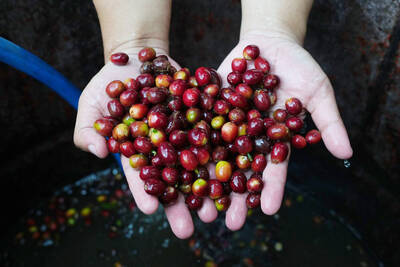A mountain chicken that’s actually a frog; a half-snake, half-lizard creature called a galliwasp; and an avian Dr Dolittle ... this is the stuff of a children’s fantasy, or perhaps a particularly vivid hallucination. In fact I was deep in the rainforest of Montserrat, discovering the bizarre local wildlife.
James “Scriber” Daley — so called because he can name every one of the island’s bird species — held up his hand to stop me in my tracks, cupped his hands to his mouth and started whistling. We were in search of the national bird, the Montserrat oriole, a shy creature no bigger than a starling. The Caribbean island, 16km long by 11km wide, is the only place where you find this particular species of oriole in the wild, yet even here they’re hard to spot; experts say there are only between 200 and 800 of them left.
Like most of the island’s human inhabitants, the oriole had two thirds of its habitat wiped out by volcanic eruptions between 1995 and 1997. Before that, tens of thousands of them lived here. The Soufriere Hills volcano had been threatening to explode for years, and in 1997 the side collapsed, sending lava streaming towards the capital, Plymouth.
Even though the evacuation was carried out in advance, and casualties were limited to 19 farmers who had knowingly strayed into the danger zone, many of the 12,000 inhabitants moved to the UK. Today, the southern part of the island is still out of bounds, so most of the remaining 4,000 people live in one small area in the north.
The lack of big luxury hotels and white beaches mean tourism was never large-scale here compared to other Caribbean islands. The little fame it garnered came from Paul McCartney, Stevie Wonder and Sting recording at the British music producer Sir George Martin’s Air Studios during the 1980s: its abandoned remains — it was destroyed by Hurricane Hugo in 1989 — are located in Belham Valley in the center of the island.
Even now, more than 10 years after the last eruptions, visitors have yet to return in significant numbers. This is partly a result of the volcano’s continued rumblings, though these are not currently dangerous, but also because access to the island is difficult: the only way in is by small plane from neighboring Antigua. But a ferry service from Antigua is scheduled to begin next month, and a yacht marina is under construction in Little Bay, which should bring more visitors.
A recent addition is Mount Pleasant eco-camp — in the Woodlands area about 20 minutes’ drive from the airport, which opened a month ago. Spread over 0.04 hectares of hillside on the edge of a rainforest, the centerpiece is Harmony Cottage — an olive green yurt with a grass roof, looking out over the Caribbean Sea. Sprinkled among the trees up hill are 12 permanent camping platforms with tents, stoves and self-inflating beds available to hire.
For David Payne, the man who built it, it has been a labor of love. “I built an eco-camp in 1995, on the other side of the island,” he said, “but just as I was about to open it the whole lot got wiped out by the volcano.” Not one to give up easily, David has recreated his vision safely out of reach from future eruptions, in the middle of the island in the Centre Hills region. He’s completed all the work himself over the past 12 months, equipping the yurt with solar-powered lights and a fridge, compost toilets and showers that draw water from a spring. The day I turned up he was sawing a huge slab of mahogany destined to become the on-site bar.
While there are more conventional places to stay on the island, including Tropical Mansion Suites (overlooking Little Bay) and Gingerbread Hill (self-catering cottages with sea views, tucked away in the hills in the parish of St Peter’s), none of them give you quite the same close encounters with wildlife. Throughout the week I saw an agouti — a cross between a rabbit and a rat without a tail — rummaging about behind the cottage, and brightly colored birds flitting around in the trees overhead.
The best bit about Mount Pleasant is that you can be in deep tropical rainforest within minutes of leaving your bed. The island’s interior is laced with hiking trails offering jaw-dropping views, and the Oriole Walkway leads straight from the campsite.
It was here that Scriber did his Dolittle impersonation. His oriole calls soon enticed a couple of curious males down to our level. “They think that a rival has come to steal their harem,” he said, “so they’re checking us out.”
One landed just above me, its black and orange plumage spot-lit by a shaft of sunlight piercing the canopy. Although still critically endangered, their numbers are now climbing thanks to a program instigated by the Royal Society for the Protection of Birds and overseen by Scriber, and we saw several more throughout the morning.
Carrying on uphill, forest thrushes and tremblers announced our arrival to other forest-dwellers — wild goats that had escaped from abandoned farms during the eruptions, and “mountain chickens,” a species of frog that earned the name for being edible.
Although the walkway is about 3km long, most of it was uphill, making it slow going, but that meant we had more time to investigate tropical plants en route — orchids, mango and mammy apple trees. After two hours we emerged on top of the canopy, around 300m above sea level. The reward was a 360° view of the island; a green hump (Antigua) rose out of the turquoise sea, and a similar distance behind that was Nevis. The only cloud in the sky was the one shrouding the volcano — a mixture of water vapor and sulfur. We could see the control tower of the original airport, now disused, poking out above a layer of thick gray ash.
I arrived back at the campsite, ready for a swim. The beaches are a silvery color, rather than the black sand you tend to get on volcanic islands, and there are two to choose from within walking distance of Mount Pleasant — Woodlands Beach and Bunkum Bay. I ambled down the hill to the latter for a quick dip before dinner, and had the whole place to myself — the crystal clear water so calm it looked like someone had stretched a layer of cling film across the top.
Just down the track from the campsite is Ziggy’s restaurant (+1 664 491 8282, ziggysrestaurant.com), run by Marcia and John Punter, who were both born in the Caribbean but grew up in the UK. It’s attracted some distinguished guests lately, including Sir Trevor McDonald, who says it is his favorite restaurant in the world. Having sampled the grilled red snapper, I can vouch for his taste, but if budget is an issue you can eat at the campsite.
David has a vegetable patch with a pick-your-own policy for guests, and after buying some parrot fish for a couple of dollars from a fisherman by the beach, I strolled back to the yurt and barbecued them with some corn-on-the-cob. As I watched the sun set over the sea, the only sound was birds chirruping in the nearby bushes. I’m not sure what they were saying. If only Scriber had been there to translate.
► On the Net: visitmontserrat.com

A few years ago, getting a visa to visit China was a “ball ache,” says Kate Murray. The Australian was going for a four-day trade show, but the visa required a formal invitation from the organizers and what felt like “a thousand forms.” “They wanted so many details about your life and personal life,” she tells the Guardian. “The paperwork was bonkers.” But were she to go back again now, Murray could just jump on the plane. Australians are among citizens of almost 40 countries for which China now waives visas for business, tourism or family visits for up to four weeks. It’s

Climate change, political headwinds and diverging market dynamics around the world have pushed coffee prices to fresh records, jacking up the cost of your everyday brew or a barista’s signature macchiato. While the current hot streak may calm down in the coming months, experts and industry insiders expect volatility will remain the watchword, giving little visibility for producers — two-thirds of whom farm parcels of less than one hectare. METEORIC RISE The price of arabica beans listed in New York surged by 90 percent last year, smashing on Dec. 10 a record dating from 1977 — US$3.48 per pound. Robusta prices have